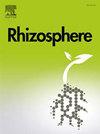Revealing the characteristics of myxobacterial communities in rhizosphere and non-rhizosphere soils of halophytic plants following wetland degradation using high-throughput sequencing
IF 3.4
3区 生物学
Q1 PLANT SCIENCES
引用次数: 0
Abstract
Myxobacteria represent a distinct group in soil microbial communities, with their predatory capabilities playing a vital role in regulating and stabilizing these communities. However, the characteristics of myxobacterial communities in the soils of Karelinia caspia (KC), a halophytic plant growing in degraded wetlands, remain unclear. In this study, we investigated myxobacterial communities in rhizosphere and non-rhizosphere soils from nine KC’ sampling sites in saline-alkaline land formed after wetland degradation using high-throughput sequencing. A total of 486 myxobacterial ASVs were identified from both rhizosphere and non-rhizosphere soil samples, comprising 2.68% of the total bacterial community. The dominant genera at the genus level were Unclassified_g_bacteriap25 and Haliangium. FAPROTAX functional predictions indicated that myxobacteria in rhizosphere soils performed various ecological functions, such as predation, organic matter decomposition, and cellulose degradation, while in non-rhizosphere soils, they primarily displayed predatory functions. The high proportion of unclassified functions suggests that many aspects of myxobacteria in soil remain unexplored. Correlation analysis showed that electrical conductivity, soil moisture, and total nitrogen significantly affected myxobacterial diversity and abundance. Co-occurrence network analysis revealed multiple associations between myxobacteria and other bacterial groups, highlighting their crucial role in maintaining the dynamic equilibrium of soil bacterial communities. These findings deepen our understanding of the relationship between microbial community dynamics and environmental factors, laying a strong foundation for future research in soil microbial ecology and conservation strategies.
利用高通量测序揭示湿地退化后卤代植物根圈和非根圈土壤中霉菌群落的特征
粘菌在土壤微生物群落中是一个独特的群体,它们的捕食能力在调节和稳定这些群落方面发挥着重要作用。然而,生长在退化湿地中的卤代植物 Karelinia caspia(KC)土壤中的粘菌群落特征仍不清楚。在本研究中,我们利用高通量测序技术调查了湿地退化后形成的盐碱地中 9 个 KC 采样点的根圈土壤和非根圈土壤中的粘菌群落。从根圈和非根圈土壤样本中共鉴定出 486 个霉菌 ASV,占细菌群落总数的 2.68%。属一级的优势菌属是未分类_g_bacteriap25 和 Haliangium。FAPROTAX 功能预测表明,根圈土壤中的粘菌具有多种生态功能,如捕食、有机物分解和纤维素降解,而在非根圈土壤中,粘菌主要具有捕食功能。未分类功能的比例很高,这表明土壤中霉菌的许多方面仍有待探索。相关分析表明,导电率、土壤湿度和全氮对粘菌的多样性和丰度有显著影响。共生网络分析揭示了粘杆菌与其他细菌群之间的多种关联,突出了粘杆菌在维持土壤细菌群落动态平衡中的关键作用。这些发现加深了我们对微生物群落动态与环境因素之间关系的理解,为今后的土壤微生物生态学研究和保护策略奠定了坚实的基础。
本文章由计算机程序翻译,如有差异,请以英文原文为准。
求助全文
约1分钟内获得全文
求助全文
来源期刊

Rhizosphere
Agricultural and Biological Sciences-Agronomy and Crop Science
CiteScore
5.70
自引率
8.10%
发文量
155
审稿时长
29 days
期刊介绍:
Rhizosphere aims to advance the frontier of our understanding of plant-soil interactions. Rhizosphere is a multidisciplinary journal that publishes research on the interactions between plant roots, soil organisms, nutrients, and water. Except carbon fixation by photosynthesis, plants obtain all other elements primarily from soil through roots.
We are beginning to understand how communications at the rhizosphere, with soil organisms and other plant species, affect root exudates and nutrient uptake. This rapidly evolving subject utilizes molecular biology and genomic tools, food web or community structure manipulations, high performance liquid chromatography, isotopic analysis, diverse spectroscopic analytics, tomography and other microscopy, complex statistical and modeling tools.
 求助内容:
求助内容: 应助结果提醒方式:
应助结果提醒方式:


